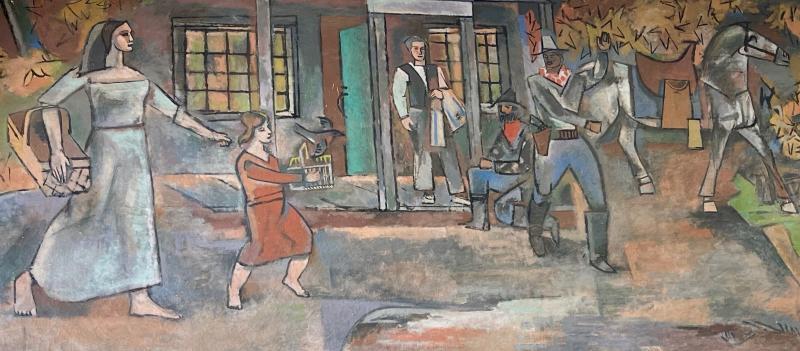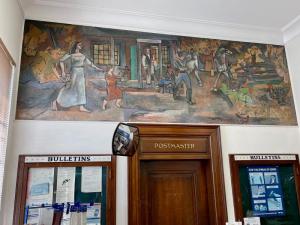Rehoboth post office painting is artistic link to federal stimulus
Russian author and philosopher Leo Tolstoy wrote about many subjects, including art. He once said that art succeeds as art to the extent that it enhances the sense of brotherhood between people.
What a noble role for art, especially at this divided moment in our nation’s history when we are thirsting for unity.
Included in President Joe Biden’s $1.9 trillion American Rescue Plan of 2021 is $135 million to support the National Endowment for the Arts. That extra funding for the federal arts organization would nearly double its current budget of $167 million. Some of that money will make its way into the pockets of the proverbial struggling artists who are among those who have been hit by the economic ravages of the coronavirus.
Such relief won’t be the first in the nation’s history. Local evidence hangs in the lobby of the Rehoboth Beach Post Office.
For 80 years or so, above the wooden door of the postmaster’s office, an oil on canvas mural painted by prominent American artist Karl Knaths greets visitors to the service window. Titled “Frontier Mail,” the colorful, Cubist-style painting depicts a cowboy-like mailman striding back to his horse after dropping off a couple of saddlebags worth of mail to a post office in a frontier village.
The painting is one of thousands commissioned between 1934 and 1943 by the federal Public Works of Art Project. That project was one portion of President Franklin Delano Roosevelt’s massive New Deal initiative to get the nation back on its feet following the Great Depression of the late 1920s and early 1930s. Part of its intent was to provide relief for the legions of people unemployed by the Depression.
Aiding struggling artists
Many artists were among the unemployed. The PWAP enabled them to gainfully ply their trade – their creative craft – while also spreading works of original art across the land in public gathering places like post offices.
There was a sense of unifying compassion in that relief measure, also borne out graphically in the Knaths piece in Rehoboth.
While the postmaster stands with the received mailbags over his arm, and the postal carrier – maybe a Pony Express rider – heads back to his horse, a young girl, followed by her mother, reaches out her arms toward the carrier with a picnic basket.
It reminds me of the cookies and other small gifts given gratefully by residents to their mail carriers during the holidays.
So what about this artist named Knaths, who was just about 50 when he painted this mural in 1940?
Wikipedia tells us this:
“Karl Knaths was an American artist whose personal approach to the Cubist aesthetic led him to create paintings which, while abstract, contained readily identifiable subjects. In addition to the Cubist painters, his work shows influence by Paul Cézanne, Wassily Kandinsky, Utagawa Kuniyoshi, Paul Klee, Stuart Davis and Agnes Weinrich. It is nonetheless, in use of heavy line, rendering of depth, disciplined treatment of color, and architecture of planes, distinctly his own.”
All of that is evident in the Rehoboth Beach piece.
There are seven PWAP works of art in Delaware post offices, according to the NewDealArtRegistry.com site. The others include one each in Selbyville, Dover, Harrington and New Castle, and two in Wilmington.
Rehoboth Beach, with its murals, sculptures, art league, theater, writers guild and live music venues, is an arts town. That figures in no small way to support the resort’s attractiveness and unique character.
This mural by the notable American artist Knaths is without question one of the city’s most significant creative works. It will be interesting to see whether the new money going into the nation’s arts brings forth more public pieces that can – as Tolstoy stated – enhance the sense of unity among us all.























































